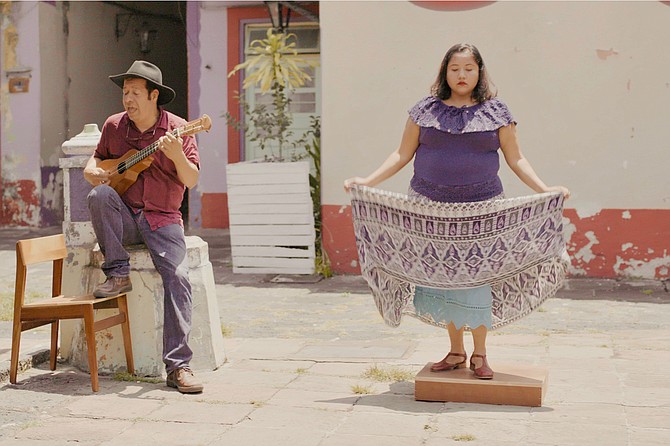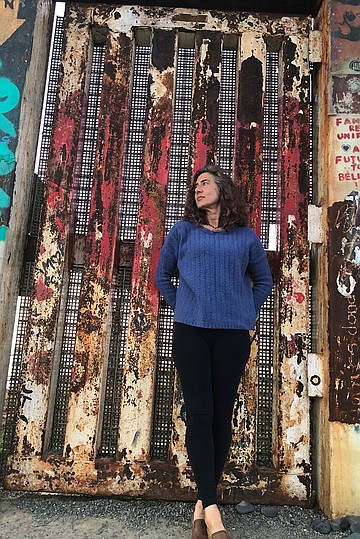 Facebook
Facebook
 X
X
 Instagram
Instagram
 TikTok
TikTok
 Youtube
Youtube

When it comes to the San Diego/Tijuana community, retired librarian Jorge Francisco Castillo counts himself pretty well settled in. He eats at Tacos el Gordo, plus Ranchos and El Zarape in North Park. He takes in music south of the border through Revolution Avenue and the Tijuana Cultural Center.
And in his own quiet, persistent fashion, he’s worked hard to improve cross-cultural relations.

Since 2008, Castillo has masterminded the Fandango Fronterizo Festival, bringing Mexican and American musicians together at the border to play, sing, and dance the fandango. Recently, Grammy award-winning musician Arturo O’Farrill, who read about the Festival in the New York Times, contacted the festival impresario about a new project. The result, recorded for posterity in the Fandango at the Wall documentary film, was a concert and live recording of the Festival at the border, featuring son jarocho musicians, recruited down in Veracruz by O’Farrill and producer Kabir Sehgal, another Grammy winner.
Castillo describes son jarocho as “a genre within the traditional music of Mexico, that was born in the south of Veracruz... music of a mestizo origin with African, Spanish and indigenous influences, that grew particularly in the peasant area of the south of Veracruz.”
Although Arturo O’Farrill grew up on the East Coast, the son of Latin Jazz bandleader Chico O’Farrill, he considers his own musical ways pretty close to son jarocho.
“The sources that inform Afro-Cuban music and Afro-Mexican music,” he explains, “are all part of that incredibly rich nexus of Spain and Northern Africa and the middle East, and all of that music was of course brought over here when people were brought to the West to be enslaved.”
“They brought with them an incredible musical legacy that influenced Cuba and influenced Veracruz … since Cuba and Veracruz are actually geographically very close, there’s a tremendous amount of inter-influence between those two cultures... [Both musics use] a layered texture in which six or seven layers come together to form a mosaic of sound, except that in Cuban music those instruments are mostly percussion instruments, whereas in son jarocho music, the layers are specifically played by jaranas [Veracruz instruments which resemble ukuleles].”
“But if you listen carefully, the layers are very similar in function, and a lot of the music is influenced by African music... It’s all music that is richly interlayered and is built along the same principles.”
Film director Varda Bar-Kar found the cultural cross-pollination fascinating, but allows that a border gathering wasn’t easy to capture.
“It took place on both sides of the United States-Mexico border and included a large amount of subjects, all of whom were important to capture,” she relates. “We had four camera units on the Tijuana side, a camera unit on the San Diego side, and a drone overhead. We deployed over a dozen microphones... We risked having the drone shot down, since it was important it be positioned overhead straddling Tijuana and San Diego.”
The film, which premiered on HBO, is available for streaming on HBO Max. It’s accompanied by a book, written by Kabir Sehgal, and a soundtrack album, released by Resilience Music Alliance.
Asked about where he’ll go next, Castillo reflected on the past while looking to the future.
“As we know, the election of President Trump was very hard for the Latino community, because of so many negative comments, and because of the construction of the wall, that sends a message that you are not welcome. But ironically, that brought us closer together.”
“The COVID-19 situation has been very hard for all the events where many people participate. The border fandango gathers between 300 and 400 people every year... For now we won’t be able to get together until everything is under control. Hopefully soon.”


When it comes to the San Diego/Tijuana community, retired librarian Jorge Francisco Castillo counts himself pretty well settled in. He eats at Tacos el Gordo, plus Ranchos and El Zarape in North Park. He takes in music south of the border through Revolution Avenue and the Tijuana Cultural Center.
And in his own quiet, persistent fashion, he’s worked hard to improve cross-cultural relations.

Since 2008, Castillo has masterminded the Fandango Fronterizo Festival, bringing Mexican and American musicians together at the border to play, sing, and dance the fandango. Recently, Grammy award-winning musician Arturo O’Farrill, who read about the Festival in the New York Times, contacted the festival impresario about a new project. The result, recorded for posterity in the Fandango at the Wall documentary film, was a concert and live recording of the Festival at the border, featuring son jarocho musicians, recruited down in Veracruz by O’Farrill and producer Kabir Sehgal, another Grammy winner.
Castillo describes son jarocho as “a genre within the traditional music of Mexico, that was born in the south of Veracruz... music of a mestizo origin with African, Spanish and indigenous influences, that grew particularly in the peasant area of the south of Veracruz.”
Although Arturo O’Farrill grew up on the East Coast, the son of Latin Jazz bandleader Chico O’Farrill, he considers his own musical ways pretty close to son jarocho.
“The sources that inform Afro-Cuban music and Afro-Mexican music,” he explains, “are all part of that incredibly rich nexus of Spain and Northern Africa and the middle East, and all of that music was of course brought over here when people were brought to the West to be enslaved.”
“They brought with them an incredible musical legacy that influenced Cuba and influenced Veracruz … since Cuba and Veracruz are actually geographically very close, there’s a tremendous amount of inter-influence between those two cultures... [Both musics use] a layered texture in which six or seven layers come together to form a mosaic of sound, except that in Cuban music those instruments are mostly percussion instruments, whereas in son jarocho music, the layers are specifically played by jaranas [Veracruz instruments which resemble ukuleles].”
“But if you listen carefully, the layers are very similar in function, and a lot of the music is influenced by African music... It’s all music that is richly interlayered and is built along the same principles.”
Film director Varda Bar-Kar found the cultural cross-pollination fascinating, but allows that a border gathering wasn’t easy to capture.
“It took place on both sides of the United States-Mexico border and included a large amount of subjects, all of whom were important to capture,” she relates. “We had four camera units on the Tijuana side, a camera unit on the San Diego side, and a drone overhead. We deployed over a dozen microphones... We risked having the drone shot down, since it was important it be positioned overhead straddling Tijuana and San Diego.”
The film, which premiered on HBO, is available for streaming on HBO Max. It’s accompanied by a book, written by Kabir Sehgal, and a soundtrack album, released by Resilience Music Alliance.
Asked about where he’ll go next, Castillo reflected on the past while looking to the future.
“As we know, the election of President Trump was very hard for the Latino community, because of so many negative comments, and because of the construction of the wall, that sends a message that you are not welcome. But ironically, that brought us closer together.”
“The COVID-19 situation has been very hard for all the events where many people participate. The border fandango gathers between 300 and 400 people every year... For now we won’t be able to get together until everything is under control. Hopefully soon.”
Comments